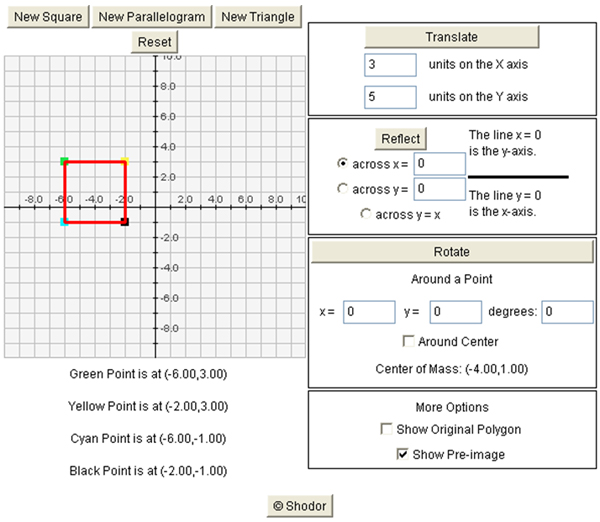
In this section, you will use an interactive sketch to investigate rotations. Click on the following link to open the applet in a new tab/window.

This sketch allows you to investigate the changes in coordinates when a rotation is applied to a geometric figure.
Next let’s investigate rotations about the origin.

You can write the rule for a rotation of 90° counterclockwise about the origin in symbolic language.
R90°(x, y) = (−y, x)
Repeat the process using a 180° rotation. (Does it matter if the 180° rotation is clockwise or counterclockwise about the origin?)
You can write the rule for a rotation of 180° about the origin in symbolic language.
R180° (x, y) = (−x, −y)
Repeat the process using a 270° counterclockwise rotation.
We can write the rule for reflections across the x-axis in symbolic language.
R270°(x, y) = (y, −x)
Since the size and shape of figures are not affected when a figure is rotated, we say rotations are congruence transformations.
The table below summarizes the effects on x- and y- coordinates for translations, reflections, and rotations.
Algebraic Representations of Transformations |
|
| Translation of h, k | Th, k(x, y) = (x + h, y + k) |
| Reflection across the x-axis | When you reflect a point across the x-axis, the x-coordinate remains the same, but the y-coordinate is transformed into its opposite. P(x, y) → Pt(x, −y) or rx-axis(x, y) = (x, −y) |
| Reflection across the y-axis | When you reflect a point across the y-axis, the y-coordinate remains the same, but the x-coordinate is transformed into its opposite. P(x, y) → Pt(−x, y) or ry-axis(x, y) = (−x, y) |
| Reflection across y = x | When you reflect a point across the line y = x, the x-coordinate and the y-coordinate change places. P(x, y) → Pt(y, x) or ry = x(x, y) = (y, x) |
| Reflection across y = −x | When you reflect a point across the line y = −x, the x-coordinate and the y-coordinate change places and are negated (the signs are changed). P(x, y) → Pt(−y, −x) or ry = −x(x, y) = (−y, −x) |
| Rotation* of 90° |
R90°(x, y) = (−y, x) |
| Rotation* of 180° |
R180°(x, y) = (−x, −y) |
| Rotation* of 270° |
R270°(x, y) = (y, −x) |
*Unless otherwise indicated, in mathematics, a rotation is assumed to be counterclockwise. |
|